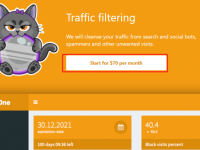What Is Cloaking and How Does It Relate to Niche E-Commerce Advertising?
————————————————————————————————————————————————————————————————————————————–
In the niche fashion or lookalike product e-commerce space, the term “cloak” is often heard. But what exactly is cloaking? And what’s the relationship between cloaking technology and an online store selling designer-inspired goods?
As is well known, the vast majority of major advertising platforms strictly prohibit certain product categories — including designer-inspired or lookalike items — from being promoted through paid ads. Platforms like Facebook, Google, Yahoo, Bing, and TikTok have clear policies against such listings. In other words, these products cannot be advertised directly and are heavily monitored. If detected, your advertising account may be suspended or permanently banned.
Yet surprisingly, we still often see these types of ads across mainstream ad networks. Is this some kind of “magic trick”?
Try visiting the Facebook Ad Library at www.facebook.com/ads/library and search for keywords like “Submariner watch” — you’ll find a variety of watch ads. Some are for authentic brands, but a fair number clearly promote lookalike or designer-style products.
Let’s take a look at examples like this:

Or like this:

So how can you tell if an ad is promoting a lookalike watch rather than the real thing? It’s fairly simple: check the ad content, landing page, and especially the price. If the ad contains non-branded terms, unusual symbols, and links to a site with ultra-low prices — it’s very likely promoting a designer-inspired product rather than a licensed brand.

So how are these ads even live on Facebook? The answer lies in cloaking technology. This is a tactic that allows advertisers to bypass ad platform detection and review, making prohibited ads appear compliant when scanned by automated systems.
————————————————————————————————————————————————————————————————————————————–
Where Is Cloaking Technology Used?
Cloaking is not unique to the designer-inspired e-commerce space. It is also used across high-risk verticals, such as:
Restricted service promotions
Affiliate offers with aggressive claims
Work-from-home or part-time job ads
Any niche where ad policies are strict or unclear
————————————————————————————————————————————————————————————————————————————–
How Does Cloaking Work?
In previous articles, I introduced the concept of cloaking. Simply put, you can think of cloaking as an ad traffic filter. It’s a mechanism that detects whether a site visitor is a real person or an ad review bot, and delivers different versions of the page accordingly.

When a niche e-commerce site installs a cloaking module, advertisers can create a filter plan. This typically includes two components:
A safe page (shown to bots and reviewers)
A target or money page (shown to real users)
Once a visitor clicks an ad, the cloaking system analyzes their HTTP header data — such as IP address, geographic region, device type, browser fingerprint, and more. It then processes this data to decide whether the visitor is a platform crawler or a human.
If it determines the visitor is a crawler or ad bot, it redirects to the safe, compliant page. If it’s a real user, it forwards them to the real offer page (often called a money page or landing page).
Advertisers can configure detailed rules for filtering traffic within the cloak module, tailoring the logic to their campaign goals and risk tolerance.
————————————————————————————————————————————————————————————————————————————
Final Thoughts
Cloaking remains a widely used — though controversial — method in high-risk or grey-market advertising strategies. For designer-inspired product sellers trying to survive in a strict ad environment, it’s often seen as a necessary tool. But keep in mind: misuse of cloaking can lead to account bans or worse if not managed carefully.
This article serves only to explain how cloaking works for educational purposes — use it at your own risk, and always stay updated with ad platform policies.
————————————————————————————————————————————————————————————————————————————-
FAQ
❓What kind of products do you offer for dropshipping?
We provide a wide range of designer-inspired fashion items including handbags, sneakers, watches, and clothing—all sourced directly from trusted factories.
❓Is there a minimum order quantity?
No. We support one-piece dropshipping, so you can start your fashion business with zero inventory risk.
❓Do you ship internationally?
Yes, we ship worldwide using reliable logistics channels designed to avoid customs issues and ensure fast delivery.
❓Are your products high quality?
Absolutely. We work with long-term factory partners and personally test product quality to ensure customer satisfaction.
❓Can I customize packaging or request private label services?
Yes, depending on volume. Contact us for customization or branding options to build your own fashion brand.


